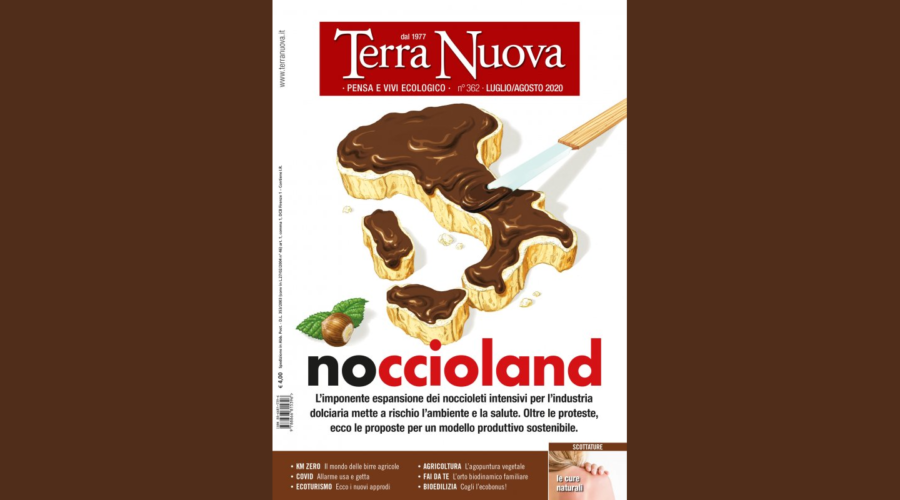
There is a growing number of local authorities, citizens’ committees and independent researchers who are calling for a more environmentally friendly agricultural production model that respects the environment, the health of citizens, the beauty of landscapes and their cultural and social meaning. It is precisely in these areas that the first victories against intensive monoculture business are being recorded; forcing it to slow down its progress and to backtrack when confronted with strong opposition from local communities. Noccioland (Hazelnut Land), the reportage edited by Manlio Masucci and published in the July issue of Terra Nuova magazine, analyzes the phenomenon of the expansion of intensive hazelnut monocultures in Italy, driven by multinationals in the confectionery sector. The reportage also documents how good agroecological practices offer an environmentally and economically valid sustainable alternative. There are several mayors who, under pressure from local city committees, have issued restrictive orders against monocultures and the chemical treatments that come with them. Among these, the ordinance of Montefiascone, a village on the shores of Lake Bolsena, is a model for all mayors who want their municipalities to start shifting towards transitionally freeing their territory from a production model that is harmful to the environment, people’s health, the local economy and social fabric.
The survey starts from the region of Tuscia, in the province of Viterbo, where 30% of Italian hazelnut groves are grown. According to the reportage, “it is precisely the Tuscia region which represents the most important frontline of a conflict that seems ready to spread to other areas of the country. Tuscia, where the problems related to this intensive cultivation are more evident, has become a laboratory where it is possible to assess both the magnitude of the conflict and the contextual resistance of alternative models. These resistances are based on organic farming and on the involvement of all local actors within virtuous economic circuits. This is, for instance, the objective of the Bio-district of Via Amerina and Forre, which, for almost ten years, has been trying to push the case for environmentally responsible agriculture.”
Increasing expansion of hazelnut groves is being demanded by multinationals, such as Ferrero, who is offering attractive bargains to producers. Yet, the monoculture model is not the only one operating in the territory. The reportage investigates and explains the arguments of organic farmers who are using local biodiversity and no pesticides to fight the most dangerous threat for hazelnut groves- the parasitic stink bug. Indeed, the profit margins of these organic farmers are relevant due to the growing demand of the organic market. Economic sustainability is therefore within the reach of organic producers and processors who intend to invest in new aggregation projects based on the enhancement of local supply chains, closed business circuits and the circular economy.
After reviewing the problems related to intensive monocultures, such as the case with drinking water in the municipalities surrounding the Lake of Vico, the survey reviews contributions from a number of experts from the University of Tuscia, ISDE (International Society of Doctors for the Environment) as well as environmental lawyers, who provide a detailed explanation of actions which could be taken at local and national levels for the protection of territories from the advancement of monocultures.
This is an important handbook at a time when monocultures seem to be advancing rapidly in the country, as they cross the borders of Lazio to reach Umbria, Marche and Tuscany. The good results obtained by territorial committees in Tuscia have led local representatives from other geographical areas to structure themselves into a national network in order to organise resistance against the advancement of hazelnut monocultures. The demands that come from the territories are for an eco-sustainable production model that takes into account the needs of soils, aquifers, landscapes and the health of citizens, and does not only focus on the extraction of raw material and profitability for corporations.
Also of importance is the issue of farming subsidies, particularly European subsidies, which continue to benefit, to a large extent, conventional agriculture, thereby making it appear artificially sustainable. The real costs, whether social, environmental, or health-related, are in fact externalized and the perception of economic viability is obtained through market manipulation. As the reportage points out, not only does the conventional model directly damage organic production, but “… without considering the economic damage to the community […], such chemical treatments have high costs both for the purchase of the chemical product and for the labour costs required for their application. In addition to this, there are increased irrigation costs, considering that chemically treated land is more thirsty than unharmed organic land, which has preserved its ability to retain water.”
An alternative production model, based on an agroecological approach, is possible. There are now many municipalities that, in order to consolidate their common efforts, are moving towards the creation of biodistricts. From the results of the experience of many, it is in fact possible to show how a local supply chain, from production to processing and marketing, can work better than a monopoly that determines absolute control over prices.
The reportage is introduced by an open letter by Terra Nuova’s director, Nicholas Bawtree, to the president of Ferrero, Giovanni Ferrero, asking him that “corporate Nutella” starts facilitating the transition to a truly sustainable production model.
Manlio Masucci, Navdanya International
Translation: Elisa Catalini and Carla Ramos, Navdanya International Team
